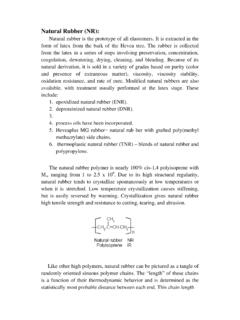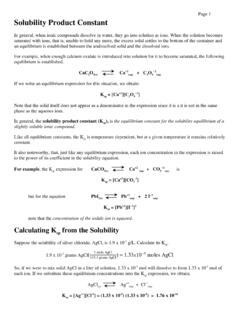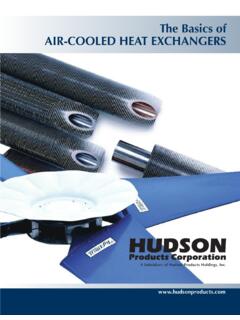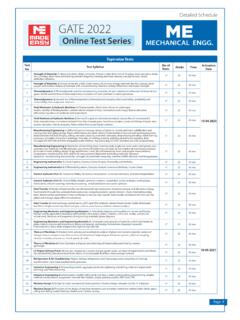Transcription of HEAT EXCHANGERS - University of Babylon
1 1 HEAT EXCHANGERS Heat EXCHANGERS are devices that facilitate the exchange of heat between two fluids that are at different temperatures while keeping them from mixing with each other. Heat EXCHANGERS are commonly used in practice in a wide range of applications, from heating and air-conditioning systems in a household, to chemical processing and power production in large plants. Heat EXCHANGERS differ from mixing chambers in that they do not allow the two fluids involved to mix. In a car radiator, for example, heat is transferred from the hot water flowing through the radiator tubes to the air flowing through the closely spaced thin plates outside attached to the tubes. TYPES OF HEAT EXCHANGERS The simplest type of heat exchanger consists of two concentric pipes of different diameters, as shown in Figure 13 1, called the double-pipe heat exchanger.
2 One fluid in a double-pipe heat exchanger flows through the smaller pipe while the other fluid flows through the annular space between the two pipes. Two types of flow arrangement are possible in a double-pipe heat exchanger: in parallel flow, both the hot and cold fluids enter the heat exchanger at the same end and move in the same direction. In counter flow, on the other hand, the hot and cold fluids enter the heat exchanger at opposite ends and flow in opposite directions. Another type of heat exchanger, which is specifically designed to realize a large heat transfer surface area per unit volume, is the compact heat exchanger. The ratio of the heat transfer surface area of a heat exchanger to its volume is called the area density . A heat exchanger with = 700 m2/m3 (or 200 ft2/ft3) is classified as being compact.
3 Examples of compact heat EXCHANGERS are car radiators ( = 1000 m2/m3). In compact heat EXCHANGERS , the two fluids usually move perpendicular to each other, and such flow configuration is called cross-flow. The cross-flow is further classified as unmixed and mixed flow, depending on the flow configuration, . In (a) the cross-flow is said to be unmixed since the plate fins force the fluid to flow through a particular inter fin spacing and prevent it from moving in the transverse direction ( , parallel to the tubes). The cross-flow in (b) is said to be mixed since the fluid now is free to move in the transverse direction. Both fluids are unmixed in a car radiator. The presence of mixing in the fluid can have a significant effect on the heat transfer characteristics of the heat exchanger.
4 2 Perhaps the most common type of heat exchanger in industrial applications is the shell-and-tube heat exchanger, shown in Figure. Shell-and-tube heat EXCHANGERS contain a large number of tubes (sometimes several hundred) packed in a shell with their axes parallel to that of the shell. Heat transfer takes place as one fluid flows inside the tubes while the other fluid flows outside the tubes through the shell. Baffles are commonly placed in the shell to force the shell-side fluid to flow across the shell to enhance heat transfer and to maintain uniform spacing between the tubes. Despite their widespread use, shell and- tube heat EXCHANGERS are not suitable for use in automotive and aircraft applications because of their relatively large size and weight.
5 Note that the tubes in a shell-and-tube heat exchanger open to some large flow areas called headers at both ends of the shell, where the tube-side fluid accumulates before entering the tubes and after leaving them. Shell-and-tube heat EXCHANGERS are further classified according to the number of shell and tube passes involved. Heat EXCHANGERS in which all the tubes make one U-turn in the shell, for example, are called one-shell-pass and two tube- passes heat EXCHANGERS . Likewise, a heat exchanger that involves two passes in the shell and four passes in the tubes is called a two-shell-passes and four-tube-passes heat exchanger. THE OVERALL HEAT TRANSFER COEFFICIENT A heat exchanger typically involves two flowing fluids separated by a solid wall. Heat is first transferred from the hot fluid to the wall by convection, through the wall by conduction, The thermal resistance network associated with this heat transfer process involves two convection and one conduction resistances, as shown.
6 Here the subscripts i and o represent the inner and outer surfaces of the inner tube For a double-pipe heat exchanger, we have Ai = DiL and Ao= DoL. 3 When the tube is finned on one side to enhance heat transfer, the total heat transfer surface area on the finned side becomes As = Atotal = Afin = Aunfinned where Afin is the surface area of the fins and Aunfinned is the area of the unfinned portion of the tube surface. For short fins of high thermal conductivity, we can use this total area in the convection resistance relation Rconv = 1/hAs since the fins in this case will be very nearly isothermal. Otherwise, we should determine the effective surface area A from As = Aunfinned = finAfin EXAMPLE 1 Hot oil is to be cooled in a double-tube counter-flow heat exchanger.
7 The copper inner tubes have a diameter of 2 cm and negligible thickness. The inner diameter of the outer tube (the shell) is 3 cm. Water flows through the tube at a rate of kg/s, and the oil through the shell at a rate of kg/s. Taking the average temperatures of the water and the oil to be 45 C and 80 C, respectively, determine the overall heat transfer coefficient of this heat exchanger. 4 ANALYSIS OF HEAT EXCHANGERS In upcoming sections, we will discuss the two methods used in the analysis of heat EXCHANGERS . Of these, the log mean temperature difference (or LMTD) method is best suited for the first task and the effectiveness NTU method for the second task as just stated. But first we present some general considerations.
8 The first law of thermodynamics requires that the rate of heat transfer from the hot fluid be equal to the rate of heat transfer to the cold one. That is, Q =m cCpc(Tc, out - Tc, in) and Q =m h Cph(Th, in - Th, out) In heat exchanger analysis, it is often convenient to combine the product of the mass flow rate and the specific heat of a fluid into a single quantity. This quantity is called the heat capacity rate and is defined for the hot and cold fluid streams as Two special types of heat EXCHANGERS commonly used in practice are condensers and boilers. One of the fluids in a condenser or a boiler undergoes a phase-change process, and the rate of heat transfer is expressed as Q =m hfg where m is the rate of evaporation or condensation of the fluid and hfg is the enthalpy of vaporization of the fluid at the specified temperature or pressure.
9 An ordinary fluid absorbs or releases a large amount of heat essentially at constant temperature during a phase-change process, as shown in Figure . The heat capacity rate of a fluid during a phase-change process must approach infinity since the temperature change is practically zero. That is, C =m Cp when T 0, so that the heat transfer rate Q =m Cp T is a finite quantity. Therefore, in heat exchanger analysis, a condensing or boiling fluid is conveniently modeled as a fluid whose heat capacity rate is infinity. The rate of heat transfer in a heat exchanger can also be expressed in an analogous manner to Newton s law of cooling as Q = UAs Tm 5 THE LOG MEAN TEMPERATURE DIFFERENCE METHOD The log mean temperature difference, which is the suitable form of the average temperature difference for use in the analysis of heat EXCHANGERS .
10 Here T1 and T2 represent the temperature difference between the two fluids at the two ends (inlet and outlet) of the heat exchanger . Counter-Flow Heat EXCHANGERS The relation above for the log mean temperature difference is developed using a parallel-flow heat exchanger, but we can show by repeating the analysis above for a counter-flow heat exchanger that is also applicable to counter flow heat EXCHANGERS . But this time, T1 and T2 are expressed as shown in Figure . Multipass and Cross-Flow Heat EXCHANGERS : Use of a Correction Factor The log mean temperature difference Tlm relation developed earlier is limited to parallel-flow and counter-flow heat EXCHANGERS only. Similar relations are also developed for cross-flow and multipass shell-and-tube heat EXCHANGERS , but the resulting expressions are too complicated because of the complex flow conditions.





